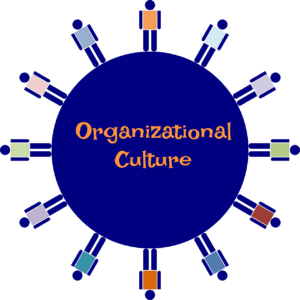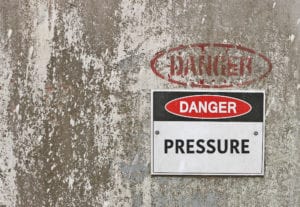 Each member of an emergency response team is guided by a unique system of values, beliefs, assumptions and norms. Every member also brings their own unique habits and routines. What happens when you combine the values, beliefs, assumptions, norms, habits and routines of many unique individuals within an organization?
Each member of an emergency response team is guided by a unique system of values, beliefs, assumptions and norms. Every member also brings their own unique habits and routines. What happens when you combine the values, beliefs, assumptions, norms, habits and routines of many unique individuals within an organization?
You create culture.
Organizational culture can be a great influencer of behaviors, both positive and negative. Culture can also influence situational awareness. Let’s explore how…
Organizational Culture
 Organizational culture is, essentially, the personality of an organization. Like an individual’s personality, it is influenced by many factors. And, consistent with individuals, there are pleasant organizational cultures and unpleasant organizational cultures. Similar to how individuals can have split personalities, so can an organization have a split culture (demonstrated by vast differences in how the members behavior may vary from shift to shift or team to team). Culture is critical because it sets expectations through norms and peer pressure. Just as society sets expectations for behaviors (rooted in laws and ethics), organizations set expectations for members (rooted in policies and norms).
Organizational culture is, essentially, the personality of an organization. Like an individual’s personality, it is influenced by many factors. And, consistent with individuals, there are pleasant organizational cultures and unpleasant organizational cultures. Similar to how individuals can have split personalities, so can an organization have a split culture (demonstrated by vast differences in how the members behavior may vary from shift to shift or team to team). Culture is critical because it sets expectations through norms and peer pressure. Just as society sets expectations for behaviors (rooted in laws and ethics), organizations set expectations for members (rooted in policies and norms).
Teaching Culture
 Some organizations are very proactive in teaching positive cultural expectations. Acceptable norms and behaviors are taught from day-one in the fire academy and during new member orientation. The expectations are then reinforced as the new member integrates into the operation. In organizations where the culture is healthy and strong, every member is tuned in to the organizational values. It is reflected in the positive and supporting demeanor each member displays at all times – toward each other, toward their bosses, and toward their customers.
Some organizations are very proactive in teaching positive cultural expectations. Acceptable norms and behaviors are taught from day-one in the fire academy and during new member orientation. The expectations are then reinforced as the new member integrates into the operation. In organizations where the culture is healthy and strong, every member is tuned in to the organizational values. It is reflected in the positive and supporting demeanor each member displays at all times – toward each other, toward their bosses, and toward their customers.
Deviations from the norm are addressed quickly and there is a high degree of accountability when a member’s behavior is deemed unacceptable. The peer-to-peer consequences can be harsh when a member deviates from the expectation of excellence. Those who comply, thrive. Those who rebel, are coached for improvement. However, where coaching fails, the member who refuses to abide by the strong, healthy organizational norms is removed. It almost sounds too good to be true that such organizations exist. But they do. They’re not perfect organizations. But their drive for a healthy culture is unrelenting.
Broken Culture
 Conversely, some organizations cultures are not as healthy. In fact, they are broken. Their “personality” is fundamentally flawed. Sadly, sometimes the members operating within such systems may not even see it. Just like that friend with the annoying personality that does not know how annoying they are, so can an organization’s culture be flawed and some members not know it. The members who don’t see it are out of focus. Or, perhaps better stated, they’re focus may be on themselves versus the greater good and mission of the organization.
Conversely, some organizations cultures are not as healthy. In fact, they are broken. Their “personality” is fundamentally flawed. Sadly, sometimes the members operating within such systems may not even see it. Just like that friend with the annoying personality that does not know how annoying they are, so can an organization’s culture be flawed and some members not know it. The members who don’t see it are out of focus. Or, perhaps better stated, they’re focus may be on themselves versus the greater good and mission of the organization.
Sometimes the members who do see what is broken try to fix it. Often times when a small number of members try to fix a broken culture they may find themselves beaten into submission. Sometimes those who know they have become part of a system with a broken culture leave. And most unfortunately, sometimes those who come into a system with a broken culture want to fit in, so they conform to the expectations of the broken culture and lose their focus as well. They comply because being “liked” is more important than doing what is “right.”
Peer Pressure Gone Awry
 Similar to the previous section where I addressed how some organizations proactively teach positive cultural expectations, some organizations proactively teach negative cultural expectation. The unacceptable norms and unacceptable behaviors are taught from day-one and then reinforced as new members are integrated into the operation. In organizations where the culture is unhealthy and weak, members are tuned in to the flawed organizational values quickly. It’s part of their indoctrination into the organization. This is reflected in the negative and degrading demeanor members display all the time – toward each other, toward their bosses, and toward the customers.
Similar to the previous section where I addressed how some organizations proactively teach positive cultural expectations, some organizations proactively teach negative cultural expectation. The unacceptable norms and unacceptable behaviors are taught from day-one and then reinforced as new members are integrated into the operation. In organizations where the culture is unhealthy and weak, members are tuned in to the flawed organizational values quickly. It’s part of their indoctrination into the organization. This is reflected in the negative and degrading demeanor members display all the time – toward each other, toward their bosses, and toward the customers.
As with the positive cultural environment, deviations from the norm are addressed quickly and there is a high degree of accountability when a member behaves in ways that are perceived by the majority of members to be unacceptable. The peer-to-peer consequences can be harsh when a member deviates from the expectation of mediocrity. Those who comply, survive. Those who rebel, are outcast from the organizational society and left in isolation. It almost sounds too sad to be true that such organizations exist. But they do. They’re not healthy and their drive to perpetuate their broken culture can be unrelenting.
The Situational Awareness Tie-In
 One of the hallmarks of an healthy organizational culture is the understanding that the most important component of the job is safety. Members know the job is hazardous and they don’t shy away from doing the dangerous work. But the culture ensures that all members are focused and have safety on their mind. A focus on safety and survival is a valued norm in an organization with a strong and healthy culture. Members who support a strong, healthy culture understand these five attributes:
One of the hallmarks of an healthy organizational culture is the understanding that the most important component of the job is safety. Members know the job is hazardous and they don’t shy away from doing the dangerous work. But the culture ensures that all members are focused and have safety on their mind. A focus on safety and survival is a valued norm in an organization with a strong and healthy culture. Members who support a strong, healthy culture understand these five attributes:
1. There is no such thing as training too much for a job that can kill you.
2. There’s no room for taking shortcuts from best practices in training or at the emergency scene.
3. Macho personas are dangerous.
4. Some members may have an unhealthy obsession with wanting to be seen as a hero.
5. Complacency and laziness can kill.
Situational awareness is founded in a first responder’s ability to: (1) Know what to look and listen for; (2) Understand what it means when they see/hear it; and, (3) Know how to make accurate predictions for future outcomes based on the previous two. Here are some of the dangerous mindsets that can destroy situational awareness skills of first responders. These come to you courtesy of SAMatters community members who have expressed their frustrations to me over the past year, both by email and during live programs presented around the globe. They are truly symptomatic of organizations with broken cultures:
“We don’t need to train. We get our training on the job.” (The person saying this is probably kicked back in the lounger, surfing the Internet, playing a video game, or reading Field & Stream magazine.)
“Hurry up and get it done. I want to get back to the station. The game is on TV in 20 minutes.” (The person saying this will probably be looking down at their wrist, but they’re not actually wearing a wrist watch.)
“Don’t play that safety bullshit on me. I’ve been doing this job for 20 years and it ain’t killed me yet.” (The person saying this is the member most feared by the the safety-minded individual because they are so dangerous.)
“It’s my sworn duty to lay down my life for someone else. Don’t get in my way or try to hold me back. This ‘no-go’ is a bunch of crap. I ALWAYS go!” (The member who says this will probably be pulling out a fist of chest hair at the same time.)
“It’s drill time, fellas. Kick back on the loungers and watch this two-hour training tape. We’ll turn the lights down low so you don’t strain your eyes.” (The member saying this may also offer the drill participants a warm, soft blanket.)
When a member adopts one or more of these mindsets, their guard is down. For whatever reason, they seem to have lost their focus. Hopefully they, at one time, were focused on the right things and weren’t hired into the organization with that mindset (though it can happen in organizations whose cultures are already broken). When the guard is down and a person is out of focus, situational awareness is vulnerable. Strong situational awareness requires keen senses – an alertness for danger – and a mindset there are no routine calls. The proverbial SA knife must have a razor sharp edge. Those who demonstrate the behaviors listed above are not sharp. They have been dulled. Their knife’s edge has been ground down to the point where it is no longer purposeful.
Rich Gasaway’s Advice
 Fixing the broken culture is the solution. It’s a simple premise. But it’s not easy because it involves changing human behavior. Before you can fix a broken culture, you need to understand what caused it to become broken in the first place. It is also worthy to note that organizational cultures don’t breakdown overnight. The problems you’re facing have likely declined slowly over years… maybe even decades. Keep this in mind. Because the repairs are likely to take as long as the decline took. In other words, there’s no easy fix to a broken culture.
Fixing the broken culture is the solution. It’s a simple premise. But it’s not easy because it involves changing human behavior. Before you can fix a broken culture, you need to understand what caused it to become broken in the first place. It is also worthy to note that organizational cultures don’t breakdown overnight. The problems you’re facing have likely declined slowly over years… maybe even decades. Keep this in mind. Because the repairs are likely to take as long as the decline took. In other words, there’s no easy fix to a broken culture.
From my observations (and a little research conducted into the problem), one of the main contributing factor to a broken culture is a deterioration of trust within the organization. Along the way, someone – or many someones – started to not trust each other. The cause seems inconsequential at this point. What you need… is a fix. If the foundation is a lack of trust, the solution is to fix the trust issue. This is actually a simple thing to do. Really, it is. But as I noted previously, it is not easy. It’s simple because all you need to do is follow a three tiered pathway. It’s not easy, however, because along the way you must repair the damage that has broken the culture.
The simple three tiers are: Communications -> Relationships -> Trust. See, I told you it was simple. If you want to understand why people are angry, discontented, complacent, lazy, and bitter, all you need to do is ask them. See, simple! No? Ok, there is a chance they’re going display a resistance to opening up to you. (That’s a nice way of saying they may tell you to $*%# off. In fact, you should expect it. They’re hurting and distrustful, which means they’re going to be guarded of their true feelings. Don’t give up.
Be gentle in how you make your approach. In other words, don’t walk up to them, in the presence of others, and say “So what’s your problem?” If you do that, expect a full-on counter attack. And you will deserve it. That would be the equivalent of cleaning out a child’s wound with a wire brush. They’re not going to like it!
Start with non-threatening communications. Chances are, the presence of courteous, professional, caring communications has been absent for a long time. That’s a tell-tale symptom of a broken culture. Where the culture is broken, most of the communications is manifested as complaints, attacks, mean-spirited commentary and criticism. These are all symptomatic of members who are hurting. They’re just not going to come right out and say “I’m hurting.” So they act out by attacking others – making others hurt too. It’s a basic premise – You hurt me, I hurt you.
Communications that displays a true caring for each other will, eventually (over time), create a relationship. In the development of a relationship, members can then start sharing their feelings about why they are hurt. The guard starts to come down. Chances are, their wounds run deep and their pain is real. There are issues that need resolved. As members help other members work through the issues (some may be as simple as offering an apology). Others may require something more tangible. Eventually, trust begins to form. Once members are back to having trust, then the process of building a healthy culture can begin. As you can see, this is a lengthy process. Just getting to trust can take years. But if you truly want to get back to a healthy organizational culture, it is worth the effort.
Fixing a broken culture is not a one person crusade. It takes the willing effort of many people who are sick and tired of working in an unhealthy (and unsafe) environment. Some members wounds may not be fixable. In that case, find ways to work around them. If you want a healthy culture bad enough, it can be achieved. Where the will is strong, the way can be found.
Action Items
 1. If you want to create a healthy culture, start by building alliances. Find others in the organization who are not happy about the broken culture. Hopefully, this can include all (or some) members of the department’s leadership team. However, it is just as likely that some members of the leadership team have been the creators of the broken culture so including them in the fix may create additional challenges (and more problems than solutions). The goal is to gain momentum through teamwork and mutual support. This is a heavy rock and the hill is steep. Don’t attempt this alone.
1. If you want to create a healthy culture, start by building alliances. Find others in the organization who are not happy about the broken culture. Hopefully, this can include all (or some) members of the department’s leadership team. However, it is just as likely that some members of the leadership team have been the creators of the broken culture so including them in the fix may create additional challenges (and more problems than solutions). The goal is to gain momentum through teamwork and mutual support. This is a heavy rock and the hill is steep. Don’t attempt this alone.
2. Create a strategy to improve communications. Discuss among the team members about how to open lines of communications with the wounded members. Get issues out on the table. Be ready. If you ask the right questions, in the right way, you’re likely to get covered in emotional vomit. Don’t take it personally. Sometimes before a person can feel better, the need to empty the soured contents in their soul.
3. Continue the communications with the purposeful goal of developing relationships. Even for those who appear crusty and resentful, don’t give up on them. If they beat you down, be even nicer to them. Remember, I said it was simple, but not easy.
4. Eventually, when you get to trust, the real core issues will be shared and you can begin working with the individuals to resolve some of the issues. Understand, some of the issues may not be solvable. Some may require resolution at a level of the organization higher than you currently reside. Be creative and resourceful. Don’t ever give up. However, don’t make promises or commitments you cannot deliver on either. That destroys the trust and relationships you’ve worked so hard to develop and you’ll be heading in the opposite direction of the fix.
5. Give plenty of praise and show lots of appreciation to those who are out of focus. Yes, it may seem like they don’t deserve it. See them as wounded warriors, not disgruntled curmudgeons. Deep down inside, they probably don’t like what they’ve become either. But they may not know how to get out of the hole they’ve dug for themselves. You can help them out by displaying patience and true concern. We go to great lengths to save the lives of strangers. Extend yourself to save the soul of a co-worker.
6. It takes time to fix what has taken years, perhaps even decades, to deteriorate. When it comes to creating a positive safety culture or fixing a broken one, there are no quick and easy solutions.
_____________________________________________________

If you are interested in taking your understanding of situational awareness and high-risk decision making to a higher level, check out the Situational Awareness Matters Online Academy.
CLICK HERE for details, enrollment options and pricing.
__________________________________
Share your comments on this article in the “Leave a Reply” box below. If you want to send me incident pictures, videos or have an idea you’d like me to research and write about, contact me. I really enjoy getting feedback and supportive messages from fellow first responders. It gives me the energy to work harder for you.
Thanks,

Email: Support@RichGasaway.com
Phone: 612-548-4424
SAMatters Online Academy
Facebook Fan Page: www.facebook.com/SAMatters
Twitter: @SAMatters
LinkedIn: Rich Gasaway
YouTube: SAMattersTV
iTunes: SAMatters Radio

Pingback: Close call survival interview with Spokane Assistant Fire Chief Brian Schaeffer
Well done.
Thank you for sharing.
What a great article @SAMatters and the Best part is you share all this information for free! Keep up your great work.